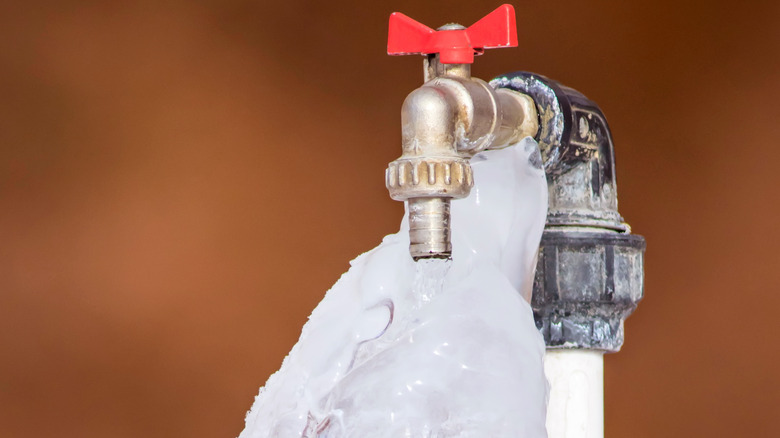How to Avoid Frozen Plumbing in Winter: Professional Tips
How to Avoid Frozen Plumbing in Winter: Professional Tips
Blog Article
This post listed below pertaining to 6 Ways to Prevent Frozen Pipes is highly compelling. Give it a try and make your own ideas.

Winter can ruin your pipes, specifically by freezing pipes. Below's how to stop it from taking place and what to do if it does.
Introduction
As temperatures drop, the danger of frozen pipes increases, potentially resulting in pricey fixings and water damages. Comprehending how to avoid frozen pipes is essential for homeowners in cool environments.
Prevention Tips
Shielding susceptible pipelines
Wrap pipelines in insulation sleeves or use warmth tape to safeguard them from freezing temperature levels. Focus on pipelines in unheated or outside areas of the home.
Heating techniques
Keep indoor rooms sufficiently heated up, specifically locations with plumbing. Open up cabinet doors to enable warm air to distribute around pipes under sinks.
Exactly how to recognize icy pipes
Try to find decreased water circulation from taps, unusual odors or sounds from pipes, and visible frost on subjected pipelines.
Long-Term Solutions
Architectural adjustments
Consider rerouting pipelines far from outside walls or unheated locations. Add extra insulation to attics, cellars, and crawl spaces.
Updating insulation
Buy high-quality insulation for pipelines, attics, and walls. Correct insulation aids keep consistent temperatures and lowers the risk of icy pipelines.
Shielding Exterior Plumbing
Garden tubes and exterior faucets
Separate and drain pipes garden hoses prior to winter. Set up frost-proof spigots or cover outside taps with protected caps.
Understanding Icy Pipes
What causes pipes to freeze?
Pipes ice up when subjected to temperature levels below 32 ° F (0 ° C) for extended durations. As water inside the pipes ices up, it increases, taxing the pipeline wall surfaces and potentially causing them to rupture.
Threats and problems
Icy pipelines can result in water system interruptions, residential or commercial property damages, and costly repair work. Ruptured pipelines can flood homes and trigger substantial architectural damage.
Signs of Frozen Pipes
Identifying icy pipelines early can avoid them from bursting.
What to Do If Your Pipes Freeze
Immediate activities to take
If you presume frozen pipelines, maintain faucets open up to soothe pressure as the ice thaws. Utilize a hairdryer or towels soaked in warm water to thaw pipes gradually.
Final thought
Preventing icy pipelines requires aggressive procedures and quick feedbacks. By comprehending the reasons, indicators, and safety nets, home owners can secure their pipes throughout winter.
6 Proven Ways to Prevent Frozen Pipes and Protect Your Home
Disconnect and Drain Garden Hoses
Before winter arrives, start by disconnecting your garden hoses and draining any remaining water. Close the shut-off valves that supply outdoor hose bibs and leave the outdoor faucet open to allow any residual water to drain. For extra protection, consider using faucet covers throughout the colder months. It’s also important to drain water from any sprinkler supply lines following the manufacturer’s directions.
Insulate Exposed Pipes
Insulating your pipes is an effective way to prevent freezing. Pipe insulation is readily available at home improvement stores and is relatively inexpensive. Pay close attention to pipes in unheated areas such as the attic, basement, crawl spaces, or garage. Apply foam insulation generously to create a buffer against the cold. You can also wrap your pipes in heat tape or thermostat-controlled heat cables for added warmth.
Seal Air Leaks
Inspect your home for any cracks or openings that could let in cold air. Seal any holes around the piping in interior or exterior walls, as well as the sill plates where your home rests on its foundation. Additionally, make sure to keep your garage door closed unless you’re entering or exiting. Leaving it open creates a significant air leak that can lead to frozen pipes.
Allow Warm Air Circulation
During cold snaps, it’s essential to allow warm air to circulate evenly throughout your home. Leave interior doors ajar to promote better airflow. Open kitchen and bathroom cabinets to help distribute heat consistently around the rooms. If you have small children or pets, be sure to remove any household chemicals or potentially harmful cleaners from open cabinets for safety.
Let Faucets Drip
A small trickle of water can make a big difference in preventing ice formation inside your pipes. When temperatures drop significantly, start a drip of water from all faucets served by exposed pipes. This continuous flow helps prevent the water from freezing. Additionally, running a few faucets slightly can relieve pressure inside the pipes, reducing the chances of a rupture if the water inside does freeze.
https://choateshvac.com/6-proven-ways-to-prevent-frozen-pipes-and-protect-your-home/

I was shown that article on Preventing and dealing with frozen pipes through a friend on our other web property. Those who enjoyed our blog posting please be sure to share it. Thanks a lot for your time. Come back soon.
Give Me A Quote! Report this page